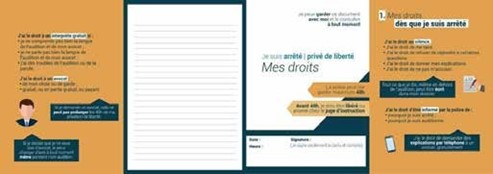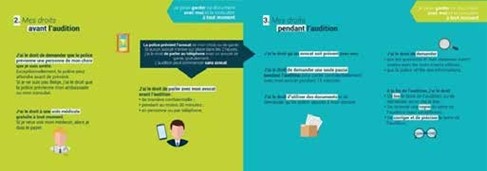Published in The Clarity Journal 82 – 2020.
Introduction
Persons under arrest receive a Letter of Rights, which explains them what are their rights : right to keep silent, right to get a lawyer, right to get medical help, etc.
But this document isn’t adapt for them to correctly understand their rights, especially as they receive it in a stressful context. The document is far too long, written in legalese style, with complicated vocabulary, unlogical structure, unnecessary information, etc.
And as a result : persons under arrest don’t read the document, or don’t read it all, or don’t understand what they read.
Persons under arrest don’t understand their rights
They are unaware of their rights, or they don’t know how to exercise their rights. They don’t know what the police officers can do and cannot do.
They don’t know that they can act in a way (for example keep silent and refuse to answer questions), without the police reproaching them this later.
Another example : if they don’t have their own lawyer, they get one “for free”, that they don’t know. They think that this is the lawyer of the police, and they don’t trust him/her. But this lawyer is present for them, he or she is there to help them. Persons under arrest need to know this, in order to receive an efficient legal help from their lawyer.
A European project called “Access Just”
This project aims to improve the access to criminal justice, mainly by clarifying all european letters of rights. This project is financed by the European Union, and carried by Fair Trials Europe and the Hungarian Helskinki Committee.
Belgium is one of the pilot countries, and Droits Quotidiens was asked to help with this work, as a legal design expert.
Droits Quotidiens rewrote the Belgian letter of rights, in order to make it clear, understandable and efficient for the persons under arrest.
Changing a document is a whole process !
Here is the methodology we followed to rewrite the Belgian letter of rights.
1. Practical training module “how to write clearly” for lawyers and judges in criminal procedures. The training goals were to :
- raise awareness on the importance to be clear ;
- teach the participants to plain legal language method ;
- work on the letter of rights.
The training included exercises on the Belgian letter of rights to :
- identify its target audience, objective, context of communication, etc. ;
- select important and relevant information to keep ;
- structure it in a logical order for the person under arrest ;
- rewrite it in plain legal language.
- Rewriting work by :plain legal language and legal design experts (Droits Quotidiens) ;
2. Rewriting work by :
- plain legal language and legal design experts (Droits Quotidiens) ;
- criminal law experts (Fair Trials) ;
- graphic designer (Droits Quotidiens).
3. Presentation to field actors (lawyers, judges, legal aid actors, etc.), in order to take their input as field actors, and to assess if the new version is :
- relevant, pertinent and usable for the persons under arrest ;
- complete enough to be legally correct.
4. Correction by the experts (Droits Quotidiens and Fair Trials), in order to improve the letter of rights thanks to the reactions and information from the field actors.
5. Presentation to a european group of plain language experts and criminal law experts, in order to :
- confront the new version to european experts ;
- Identify the cultural and national aspects that must be taken into account ;
- show one example for their own work in their country on their letter of rights.
6. Presentation to police officers, in order to confront the new version to the field, and to assess if the new version is :
- usable for police officers ;
- relevant for the persons under arrest ;
- matching their needs (the needs of both police officers and persons under arrest).
7. Corrections by the experts (Droits Quotidiens and Fair Trials), in order to improve the letter of rights thanks to the reactions and information from the field actors.
8. Confrontation to persons under arrest, and testing : “How do they understand their rights :
- with the former version of the Letter of rights ?
- with the new version?”
This step is still to be realized, at the time I write this paper.
9. Argumentation and plea for the ministry of justice to make the new version mandatory for all criminal justice actors.
Here is an overview of the former version and the new version.
Former letter of rights
- 4 pages
- Only text
- Too much information, and irrelevant information for the person under arrest.
- Maybe useful for a lawyer, but not for the target audience.
- Similar information at different places, creating unnecessary repetitions, and risk of confusion.
- Complicated vocabulary, legalese style, complicated formulations.
- Long sentences, with a complicated structure.

New letter of rights
- 1 practical leaflet : short and easy to keep (pocket size)
- Less information : only pertinent and important information for the person under arrest. For example, we removed the information about the rights of the person if she’s taken to the examining magistrate (prosecutor).
We removed it for mainly 2 reasons :
If you want the person to read, understand and remember the information, you must give her the information at the right moment. So only if she’s in a situation that makes her need this info.
In this case, the person needs this information at the moment she’s taken to the prosecutor.
Before that moment, this information is irrelevant for her.
- It is very stressful for the person to talk about the prosecutor while she’s only under arrest, and not yet suspected for anything. Being arrested is already stressful enough. Let’s not add unnecessary stress.
- Color code.
- Highlight important information and key words.
- Visual structure, pictograms, lay-out that helps the comprehension.
- Usual vocabulary, day to day words.
- Sentences easy to read, short, and simply structured.
- Similar information grouped together.
- Structure :
- Logical for the person :
- What info does she really need ?
- What info does she need first ?
- What info is important for her ?
- Logical for the person :
- First : important rights (they were on the last page in the former version)
- Then :
- Always, as soon as the person is arrested (before and during the audition)
- Before the audition
- During the audition
- In another document : rights if the person is taken to the examining magistrate (prosecutor).
Here are some pictures of the new version, when folded.
This is the new version, that still needs to be folded.




